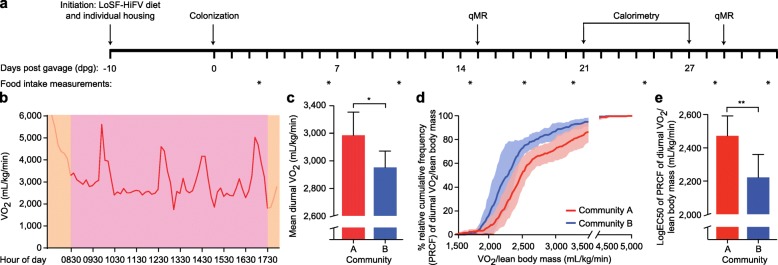Fig. 2.
Comparison of the effects of two different consortia of cultured human gut bacterial strains on energy expenditure. a Experimental protocol. Mice underwent qMR measurements, indirect open-circuit calorimetry, and quantitation of food intake at the time points indicated. b Example of diurnal indirect open-circuit calorimetry of a mouse colonized with consortium A placed in the metabolic chamber at 0600 h with free access to water but not food. Red tracing indicates the measurements used to calculate mean diurnal VO2. Orange denotes periods excluded from the analysis when the mouse was initially placed in the metabolic chamber and when the chamber was open for introduction of food at 1730 h. c Mean diurnal VO2 in mice colonized with bacterial consortium A from the lean co-twin compared to bacterial consortium B from the obese co-twin (data derived from measurements made from six animals/treatment group from dpg 21 to 27; mean values ± SD are plotted). d Percent relative cumulative frequency (PRCF) of diurnal VO2 in mice colonized with consortium A compared to mice colonized with consortium B. Solid lines represent mean values with the shaded areas indicating the standard deviation. e LogEC50 of PRCF of diurnal VO2 in animals containing consortium A and consortium B. *P < 0.05; **P < 0.01 (Student’s t test). Abbreviations; qMR, quantitative magnetic resonance; LoSF-HiFV, low saturated fat, high fruits and vegetables diet

